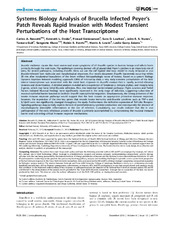| dc.creator | Rossetti, Carlos A. | |
| dc.creator | Drake, Kenneth L. | |
| dc.creator | Siddavatam, Prasad | |
| dc.creator | Lawhon, Sara D. | |
| dc.creator | Nunes, Jairo E. | |
| dc.creator | Gull, Tamara | |
| dc.creator | Khare, Sangeeta | |
| dc.creator | Everts, Robin E. | |
| dc.creator | Lewin, Harris A. | |
| dc.creator | Adams, Leslie Garry | |
| dc.date.accessioned | 2014-02-27T21:37:18Z | |
| dc.date.available | 2014-02-27T21:37:18Z | |
| dc.date.issued | 2013-12-09 | |
| dc.identifier.citation | Rossetti CA, Drake KL, Siddavatam P, Lawhon SD, Nunes JES, et al. (2013) Systems Biology Analysis of Brucella Infected Peyer’s Patch Reveals Rapid Invasion with Modest Transient Perturbations of the Host Transcriptome. PLoS ONE 8(12): e81719. doi:10.1371/journal.pone.0081719 | en |
| dc.identifier.uri | http://dx.doi.org/10.1371/journal.pone.0081719 | |
| dc.identifier.uri | https://hdl.handle.net/1969.1/151490 | |
| dc.description.abstract | Brucella melitensis causes the most severe and acute symptoms of all Brucella species in human beings and infects hosts
primarily through the oral route. The epithelium covering domed villi of jejunal-ileal Peyer’s patches is an important site of
entry for several pathogens, including Brucella. Here, we use the calf ligated ileal loop model to study temporal in vivo
Brucella-infected host molecular and morphological responses. Our results document Brucella bacteremia occurring within
30 min after intraluminal inoculation of the ileum without histopathologic traces of lesions. Based on a system biology
Dynamic Bayesian Network modeling approach (DBN) of microarray data, a very early transient perturbation of the host
enteric transcriptome was associated with the initial host response to Brucella contact that is rapidly averted allowing
invasion and dissemination. A detailed analysis revealed active expression of Syndecan 2, Integrin alpha L and Integrin beta
2 genes, which may favor initial Brucella adhesion. Also, two intestinal barrier-related pathways (Tight Junction and Trefoil
Factors Initiated Mucosal Healing) were significantly repressed in the early stage of infection, suggesting subversion of
mucosal epithelial barrier function to facilitate Brucella transepithelial migration. Simultaneously, the strong activation of the
innate immune response pathways would suggest that the host mounts an appropriate protective immune response;
however, the expression of the two key genes that encode innate immunity anti-Brucella cytokines such as TNF-a and
IL12p40 were not significantly changed throughout the study. Furthermore, the defective expression of Toll-Like Receptor
Signaling pathways may partially explain the lack of proinflammatory cytokine production and consequently the absence of
morphologically detectable inflammation at the site of infection. Cumulatively, our results indicate that the in vivo
pathogenesis of the early infectious process of Brucella is primarily accomplished by compromising the mucosal immune
barrier and subverting critical immune response mechanisms. | en |
| dc.description.sponsorship | The open access fee for this work was funded through the Texas A&M University Open Access to Knowledge (OAK) Fund. | en |
| dc.language.iso | en_US | |
| dc.publisher | PLoS | |
| dc.rights | Attribution 3.0 United States | en |
| dc.rights.uri | http://creativecommons.org/licenses/by/3.0/us/ | |
| dc.title | Systems Biology Analysis of Brucella Infected Peyers Patch Reveals Rapid Invasion with Modest Transient Perturbations of the Host Transcriptome | en |
| dc.type | Article | en |
| local.department | Veterinary Pathobiology | en |
| dc.rights.requestable | false | en |



